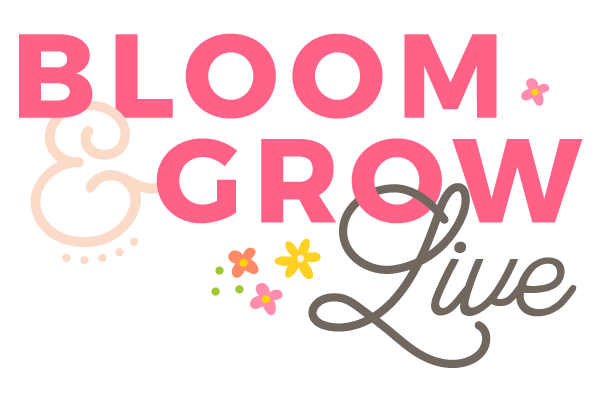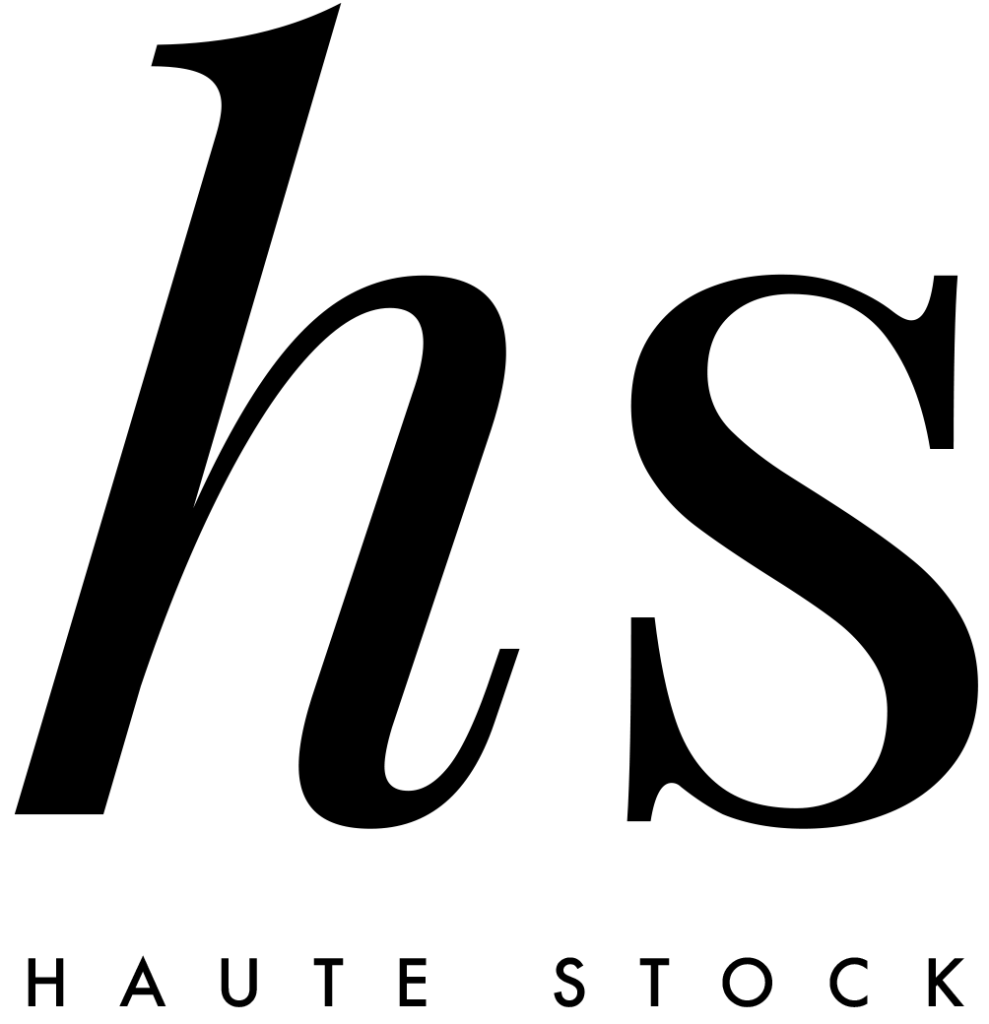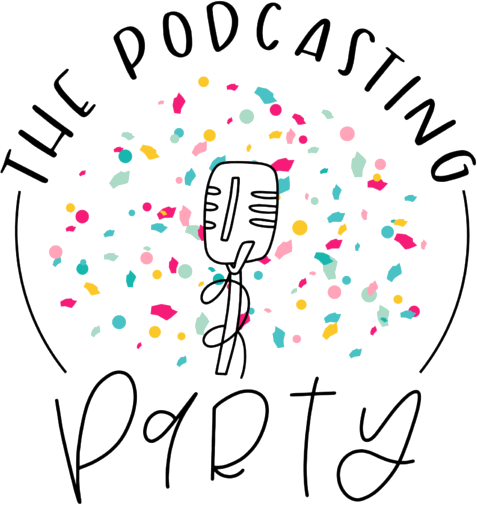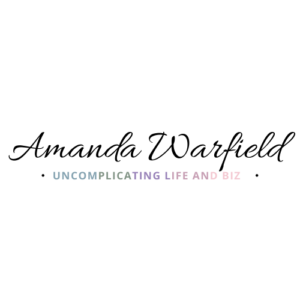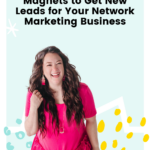
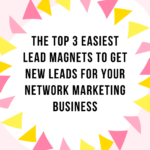

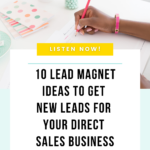
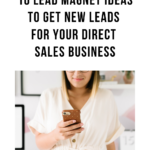
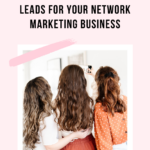


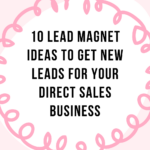
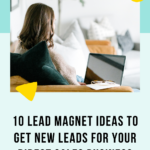

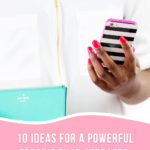



One of the easiest ways to attract people to your business is to give something away for free that will get them excited and wanting more… but what exactly should you give away? It can’t cost too much, but it needs to be valuable. It can’t be too difficult to create or share, but it needs to be worth their time.
Today I’m sharing 10 ideas for a powerful freebie or lead magnet that will attract highly qualified leads to your business who are excited to work with you! I’m even going to break it down further to give you the top 3 easiest freebies to create and also share which 3 take a little more effort and are better saved for later.
Prefer to read the blog?
Episode Transcript
029. 10 Ideas for a Powerful Freebie That Attracts High Quality Leads
0:00
Hey there friends welcome to another episode of the build like a business podcast. I'm so happy that you're here. Before we dive into today's episode, I just want to take a quick second to invite you to my free five day challenge leads for a lifetime. During this five day challenge, I'll hold your hand as we cover how to stay laser focused on attracting high quality, qualified leads to your business, how to transform your lead life so that when you ask for the sale, it's a no brainer for them to say yes, how to bridge the gap so that you can start converting those leads into paying customers how to level up your personal brand image so that people instantly trust everything you have to offer, and how to automate your leads follow up so that you can build forward momentum in your business and keep your customers coming back for more over and over and over again. By the end of this challenge, you'll have a clear lead generation strategy and the tools you need to put it on autopilot without having to ask for referrals, contact friends and family or cold message your Facebook friends list. If you've ever wished that you had a steady stream of hot leads flowing into your business, this is for you. And you can grab your free ticket to the leads for a lifetime challenge at anchor design co.com slash challenge. I can't wait to see you there. And now let's dive into today's episode. You might be in business for yourself, but you don't have to be by yourself. My name is Kelly Lauer Minh and I'm here to help you stand out in a crowded market. Work smarter, not harder, and build a profitable business that lasts a lifetime. Whether you're feeling a little in over your head stuck on the same old way of doing things that you happen for years, or you have a to do list a mile long and just don't know where to start. You're in the right place. Marketing Strategy, getting leads money management, growing your team. The build it like a business podcast is your one stop shop for everything you need to ditch the side hustle mindset and truly build it like a business. Let's dive in.
2:16
Hi, friends, welcome back. I'm so glad you're here today. And I'm really, really excited to talk about freebies for your business to help you attract leads. Because this is literally the lead generation strategy that I built my entire business on. This allowed me to grow really quickly reach the right people, people that I was excited to work with who were in turn, excited to work with me. And so what I want to share today is some ideas to help get the juices flowing, so that you can use the strategy in your business too. So I'm going to walk you through 10 ideas for powerful freebies, that actually attract high quality leads, who really want to do business with you. So let's go ahead and dive right in. For each of these. I'm going to share an idea for a freebie. And then I'm also going to give you some examples. And we're going to try to use a really wide range of industries and types of businesses from direct sales businesses to online business to in person businesses. That way I can really make sure that no matter who you are, and what type of business you have, you can walk away from this with some ideas. So let's go ahead and dig right in. So the first one that I want to talk about is a workbook or a worksheet. Now workbooks and worksheets are both interactive, and they teach something so they're kind of a twofer. This could mean that you use fill in the blanks. This could mean that the person reading it is responding to prompts. But either way, no matter what the formatting is, the purpose of a workbook or worksheet is that they don't just give information to the person who downloaded it. They asked that person for input as well. So if you think back to like mad libs, if you ever did those in like middle school or high school, or if you ever did a worksheet to prepare for a test, or maybe to take notes, that sort of thing, where you had to fill in the blanks or respond to questions, and that's a worksheet you're learning. But you're also inputting information you're writing things in or you're doing something that's interactive. So some examples of workbooks or worksheets could be a finance worksheet, maybe to help you save up for something or get ready to buy a house. It could be a worksheet to help you write an outline for a book or to write a blog post or a social media post. It could be journal prompts, that sort of thing. So those are all workbooks or worksheets or things that a worksheet or workbook could be based around. Now, idea number two is a checklist. So checklists break down information into one of the simplest forms. It's literally just information in a checklist. We're not going super in depth, you're just giving the basics and this can
5:00
can be really good for the person who's reading it because it feels like instant gratification, it's very easy to understand. So it leaves them feeling really good. They don't feel like oh, this is hard, they don't feel like they don't know enough, they instantly feel really good because they understand it very easily because the information itself is very simple. This can be really good for an audience that might get overwhelmed easily or really just as getting started. They're new at whatever they're doing. So some examples of a checklist could be five beauty products, every busy mom needs in her makeup bag. 10 essential crafts for your kindergartener, the four things you need to start doing now, if you want to save $1,000 by the end of the year, or maybe even six, high protein breakfast that will keep you full all day. So it's a checklist where you're just sharing the information is laying it out there, you're not necessarily going in depth or teaching. Now, the third one is a calendar. So these can be really fun and creative. So if you're the creative type, this could be an interesting one for you. Basically, you're making a list of important dates or times to help the person who downloaded it, remember something or prepare for something. So you could do this yearly, could be a weekly calendar could be monthly, quarterly, or you could do even on a smaller scale, such as like a daily calendar, so something that you do daily. So a few examples are a weekly calendar of your skincare routine, where maybe you show your daily skincare routine of cleansing, toning, moisturizing, so the basics. And then you also show what days to exfoliate or do a mask. So that might be on a weekly basis. You could also do a calendar of holiday crafts, if you have a crafting business. So maybe you list out all of the different holidays on a calendar, and then you put a fun craft for each of them. You could even do a calendar of essential oils to use maybe based on like the moon phase or based on something do whatever your audience is into. So if they're feeling a little more of the crunchy granola side, they might be into the moon phase thing. If they're not, if they're really like logic and facts, they might want to do something else, they might not want the moon space thing. So think about what your audience wants, and what they're into, and then go in that direction, embrace that. Number four is a process roadmap. So this is kind of like a checklist. But it's more in depth. a checklist is really simple. It just lays out the information. But it really doesn't go deeper into how or why or teaching. And so again, this is still valuable. For audiences that might get a little bit more overwhelmed easily or they're new, they might just want a checklist they want the basics. But a process roadmap is like a checklist, but it adds the explanation for each step, it adds the details. So this might be for someone who's maybe if you're working with business owners, someone who's been in the game for a little while and wants that next step, they really want you to hold their hand a little bit more. But they don't, they're not ready for like a course or something like that. So that's where a roadmap could come in. So some examples of a roadmap could be a process for getting acne free skin in three months, or a process for how to do a certain craft where you just write out the instructions. This could be a process for how to get to a leadership position in your direct sales business, a process for how to write a book. Remember, in your process roadmap, you're going deeper than a checklist, you're actually giving the How to you're giving the information, the process for how to do something, why to do something, that sort of thing. And then next, we actually have something called a cheat sheet, which is kind of like a cross between a roadmap and a checklist. So these three all really go together. Well, they're sort of in sequence. So a cheat sheet gives you helpful tips on how to do something, but it doesn't go in depth the way or roadmap does. But it does give a little bit more information than a checklist. So here's how you can kind of visualize it if that feels a little bit jumbled in your head right now. So here's a visual. a checklist is a list where each bullet in the list is really just a few words kind of like a title right? Then you have a roadmap where you have a paragraph for every item in the list, you're really going in depth than a cheat sheets in the middle, just a sentence or so for each item in the checklist. See how we're going from a few words versus a sentence versus a paragraph. We're giving a little more information with each of them. So the cheat sheet is in the middle. This is where you're giving a little more information than a checklist, but you're not necessarily giving the whole entire step by step process, like a process roadmap. Some examples of a cheat sheet could be a cheat sheet for how to get flawless skin with only three products five hacks to make
10:00
Cleaning your house easier, a busy moms cheat sheet for starting a business, that sort of thing. And I will tell you that especially for a cheat sheets, roadmaps and checklists, because these three go hand in hand, any of the examples I gave could really be used for any of them. It's not the example that's important. It's the amount of information that you give that separates the three of these. So those are the first five we had workbooks or worksheets, number one, checklists, number two calendars, number three, process roadmaps, number four, and then cheat sheets was number five. So number six is a mini course, this is generally in a video format. And it really does require a little more technical skills. So if you've never used a lead magnet before, you don't really have that engaged of an audience yet, you're still building up to that I don't recommend starting here. But mini courses can be really cool because you basically record two or more videos where you teach something. So you could use a learning management software to manage these videos to handle the actual course portion of it. Or you could go really basic and create a PDF that just links to like an unlisted YouTube video for each of the videos in your mini course. So you can go with the professional software, you could go really basic. But the purpose of point of this is that you would have two or more videos, it's a course where you would have modules that you're going through. Again, as I'm sure you're hearing, as I say this, this does take a little bit longer, and requires a little more technical skill. So I don't recommend starting here. But if it interests you, then I would definitely save this as an idea once you've gotten a really good feel for what your audience needs and likes and responds to so use some of the easier lead magnet or freebie ideas, and then test with those. And then once you've got a feel for what your audience needs, wants and responds to then try something that is a little bit more time consuming, and a little bit more in depth like a mini course, examples of a mini course could include a course on how to work with brides as a makeup artist. So it's something where you have multiple steps, it's going to take more than just one quick video, you need more than one video to share, it could be a course on how to shift your mindset, a course on cooking in a certain type of cuisine, where you walk them through all the different information about it. Again, something that requires more than one video to actually get all the information out there. Now, number seven is a script. These are particularly good if you're in the information space, versus a physical product. Okay, so selling something that's informative versus selling a physical product. A script is basically when you give someone the words for a specific situation so that they don't have to figure it out alone. So you can kind of see where that would lend itself really well to someone selling a course or coaching, or digital services like that versus selling a physical product. Some examples of a script could be how to talk to your husband about money, how to negotiate prices, an email script or texting script, anything like that, where you're giving the words, you're telling someone what to say in a specific situation, whether that's talking, whether that's texting, whether that's emailing doesn't matter. As long as you're giving words, that's a script. And then next after that, we have number eight, which is a template. And a template is kind of like a script where you're giving someone the foundation to do something, and they just need to add their personal touch. But this isn't a script because we're not giving words, generally a template is going to be more visual. So this could be something like a Canva template, or this could be some type of social media template, that sort of thing. So it could also be a template for a craft or even a template for journaling every morning or every night. And then after that, our next one is number nine, which is an educational guide. A Guide is one of the easiest types of freebies to create, and actually get people to download. You're basically just sharing information to educate someone on a specific topic. You're teaching something that you already feel really confident and comfortable with something that you already know and are an expert in. The most important thing about an educational guide is that it needs to solve one very specific problem. This is what makes a guide different from a checklist or roadmap. It goes a lot further in depth on a subject and it really hones in on solving one specific problem versus covering a wide range of topics. You want your audience when they download your educational guide to walk away having solved a problem in their life or business or you know
15:00
Whatever it is, that's related to what you're actually working with them for, or selling to them. So some examples of educational guides could be how to organize your closet without feeling overwhelmed. The ultimate eco friendly skincare routine, busy moms guide to high protein kid friendly breakfasts, 10, jewelry trends for 10 fashion trends or, and any kind of trend every woman needs when climbing the corporate ladder, or the Ultimate Guide to mastering knife skills like a pro and under an hour, or how to use aroma therapy to alleviate stress and anxiety. So when you're hearing these, I want you to really notice in this specific type of lead magnet or in this specific type of freebie, the educational guide, you're getting super specific about the problem you're solving. We're solving the overwhelm when you're organizing our closet, we're solving the fact that kids are hungry 24 seven, it seems they never stop eating. So we're solving that with high protein breakfast, where solving the problem of looking professional when you're climbing the corporate ladder, we're solving the specific problems of stress and anxiety. We're saying it right in the title and then we're following through on that in the educational guide itself, by staying on topic and really focused. And then number 10 is an on demand workshop. an on demand workshop is kind of like a cross between a course and a guide. So this is a single video instead of multiple videos like a course. And it walks the person who downloads it through something step by step kind of like a guide, it doesn't go super deep into a broad subject the way of course does. Instead it focuses and stays really specific on one small area, and gives more basic information about that one specific focused topic kind of like an educational guide will do. So a few examples of on demand workshop ideas would be how to do a certain craft or how to achieve a specific makeup look, creating an essential oil blend organizing just one cupboard in your kitchen versus the entire kitchen, which would be a little bit too in depth for workshop and might be better suited for a mini course, the point of the workshop is really going to be something where you can better serve your audience through a video where they can see you and follow along versus actually reading through. So a guide is going to be something where they can skim and read through and they don't need to see you. But for example, if you're teaching how to do a makeup look, it could be helpful if you don't have pictures. To illustrate what you're trying to do, it could be helpful to have a video tutorial in the form of an on demand workshop. So there are your 10. So let's go back and just quick recap them. We have workbooks and worksheets, checklists, calendars, process roadmaps, cheat sheets, mini courses, scripts, templates, educational guides, and on demand workshops. And now I know that that was kind of a lot. And you might feel a little bit like you're not sure where to start, which one is the right one to go with. Or you might be leaning on one but unsure if that's really the best one to go with first. So I want to leave you with my top three picks for freebies, I would recommend starting with and then also my top three picks for freebies, I'd probably save for it later. And I wouldn't start with. So let's go ahead and dive into that. And one thing to remember is that the more you ask of somebody, the more you need to give. Okay, so the more you're asking of someone, when they download your lead magnet, the more you have to give with your lead magnet. And also, the more you're going to have to give in order to get them to actually download because also, the more that you ask of someone, the harder it is to get someone to commit. And I don't say that to scare you off. But I do want you to go into your lead magnet with some realistic expectations. Because for example, and I'm going to talk about my top three to leave behind, and top three to start with. But for example, if you go in expecting super high conversions on a mini course, you're going to be disappointed because courses require effort from the person who's downloading it, they require a higher commitment. And so it takes more in order to get someone to actually sign up for it. Now I'm not going to get all into that because there's some science behind why you would actually choose that one. But that's for a whole different podcast episode. So message me on instagram anchor design co if you want me to create that podcast episode and walk through the science behind that a little more in depth, but for now let's just do the top three to start with and the top three to save for later. So top three to save for later or workshops, courses and scripts. courses and workshops require a lot of commitment from the person
20:00
Who's downloading it. So instead of just downloading it and skimming through and reading it really quick, they actually have to find time to listen and watch. So they might need to get on a computer, they might need to make extra time versus something they just download and can read through, they can just do that on their phone, like in the mall, like it doesn't matter where they are. So courses and scripts take a lot more effort, which means it's going to take a lot more effort from you to actually get people to download it. And after they download it to get them to actually use it. scripts, I bring up as one of the three to save for later. Because they're so specific, they're really ultra targeted, there's a really specific like, super, super, super specific person who needs a script, they both have to have the problem. And they have to want someone else to actually solve it for them, which narrows down who is going to download it. So this can be a little bit too targeted for some audiences. And also, because it's so targeted, it can take a little bit more digging to actually find the person. So those are the three I would say for later, workshops, courses, scripts, the three that I would start with our educational guides, checklists, and cheat sheets, because these are really, really, really easy to create. And they also require very low commitment from the person who's downloading it. So they tend to convert faster and more frequently. They also use skills that you already have, and don't require much learning or investment on your part, you can make a guide or checklist or a cheat sheet and Canva or really any free design app that you like using, and you can deliver them in an email with very little commitment from the person reading it, like I said before, they can just skim through doesn't matter where they are, versus a course where they have to actually make time they need to be able to listen, they need to be able to watch. So those require a lot more time and commitment from the person. They also require some type of video software or learning management software from you. Whereas guides checklists and cheat sheets, they really just require you to make a PDF, which is so very simple. And we can all do that. And if you have to learn how to do it really doesn't take much to learn how to do it. So those are the ones I would start with educational guides, checklists and cheat sheets. And the ones I would save for later are workshops, courses and scripts. So I hope that that was helpful. And I would love to know what freebie you're going to create first. So if you want to send me a message on Instagram, you would make my day you can find me at anchor design co on Instagram. And I would love to know what you're going to start with first. And if you're ready to create your first freebie, but maybe you just want a little extra support, you want some feedback, you want someone to kind of guide you through how to actually do it from start to finish, I'd love to invite you to my free leads for a lifetime five day challenge. During the free challenge, I'm going to hold your hand every day for five days while I actually walk you through creating your first freebie or lead magnet. And we'll do everything together from coming up with the idea to designing your lead magnet all the way through actually delivering it to your audience and finding people to download it so we'll do everything together and it's totally free. So I'd love to invite you to that you can get your free ticket for the leads for a lifetime challenge at anchor design co.com slash challenge I hope that we'll see you there even if you're listening to this after we get started please come over and join because there will be replays available from every single day of the challenge so you can easily catch up you can always post in the group and say hey, what I missed, I'll get you all the links show you where to go to get caught up. But I hope I'll see you there grab your free ticket at anchor design co.com slash challenge. Alright my friends thank you so much for being here with me today. I cannot wait to see what lead magnet you create first what freebie you're gonna start with again, send me a message and I hope we'll see you at the challenge. Bye for now.
24:07
Three cheers to you. You just wrapped up another episode of the build it like a business podcast. Want to keep the party going. Head on over to anchor design co.com slash podcast to find show notes, free business tools and links to everything mentioned in today's episode. And if you're looking for a community of women who are dedicated to building sustainable, profitable businesses that you can network with, come on over and join us in the build it like a business Facebook group. There is a seat waiting for you inside the community find a link to join at anchor design co.com slash podcast
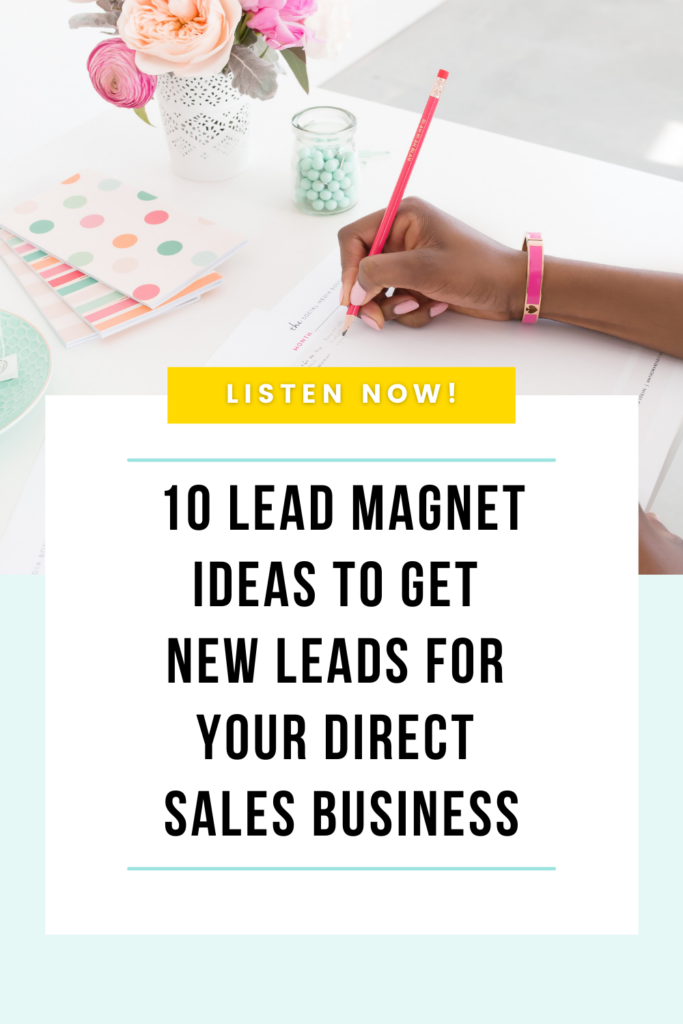
LISTEN, FOLLOW & REVIEW ON:
Apple Podcasts
Click to listen >>
Spotify
Click to listen >>
Audible
Click to listen >>
Google Play
Click to listen >>
Episode Links
- Join the FREE Leads for a Lifetime Challenge
- Connect with Keleigh on Instagram
- Follow Anchor Design Co. on Facebook
- Join the Build it Like a Business Community
- Get a FREE AnchorCard Digital Business Card


Ready to create your first freebie?
Join the FREE Leads for a Lifetime 5 Day Challenge!
During this free challenge I’m going to hold your hand every day for 5 days while I walk you through creating your first freebie, or lead magnet – we’ll do everything together from coming up with your idea to designing it, all the way through delivering it to your audience!
Search for a topic!
Find the support you need to grow your biz

